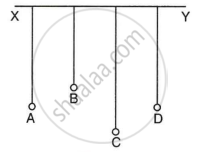Advertisements
Advertisements
Question
Differentiate between the following:
Light and sound waves.
Solution
| Light waves | Sound waves |
| 1. These are electromagnetic waves. | 1. These are mechanical waves. |
| 2. They can travel in vacuum. | 2. They re qui re a materia I medium for propagation. |
| 3. The speed of light waves is very high ( = 3 x 108 m/s in air). | 3. The speed of sound waves is low ( =3 30 m/s in air). |
| 4. The wavelength of the light waves (visible) is very small, of the order of 10-6 m. | 4. The wavelength of sound waves is in the range of 10-2 m to lOm. |
| 5. These waves are transverse. | 5. These waves are lonaitud ina I waves. |
APPEARS IN
RELATED QUESTIONS
How does the medium affect the amplitude of free/natural vibrations of a body?
What are forced vibrations?
Name the phenomenon involved in tuning your radio set to a particular station and define it.
In fig. shows two tuning forks P and Q of the same frequency mounted on separate sound boxes with their open ends facing each other. The fork A is set into vibration. (i) Describe your observation. (ii) State the principle illustrated by this experiment.

In Fig. A, B, C and D are four pendulums suspended from the same elastic string XY. The lengths of pendulum A and D are equal, while the length of pendulum B is shorter and of the pendulum C is longer. Pendulum A is set into vibrations.

- What is your observation about the vibrations of pendulum D?
- Give reason for your observation in part (a).
- What type of vibrations take place in pendulums Band C?
- Give reason for the answer in part (c).
Differentiate between the following:
Radio waves and light waves.
A string stretched between its ends is made to vibrate by placing the stem of a vibrating tuning fork at its one end. State three ways how you will increase the frequency of note produced by the string.
Explain Why are stringed musical instruments provided with large sound boxes?
